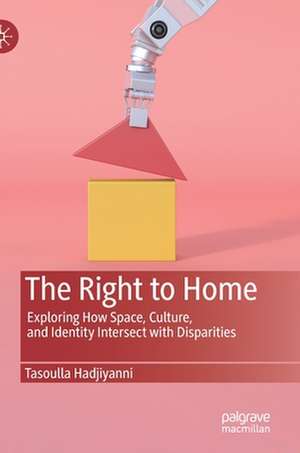The Right to Home: Exploring How Space, Culture, and Identity Intersect with Disparities
Autor Tasoulla Hadjiyannien Limba Engleză Hardback – 6 sep 2019
Preț: 584.73 lei
Preț vechi: 687.92 lei
-15% Nou
Puncte Express: 877
Preț estimativ în valută:
111.96€ • 116.58$ • 92.89£
111.96€ • 116.58$ • 92.89£
Carte tipărită la comandă
Livrare economică 14-28 februarie
Preluare comenzi: 021 569.72.76
Specificații
ISBN-13: 9781349959457
ISBN-10: 1349959456
Pagini: 288
Ilustrații: XV, 332 p. 21 illus., 18 illus. in color.
Dimensiuni: 148 x 210 mm
Greutate: 0.72 kg
Ediția:1st ed. 2019
Editura: Palgrave Macmillan US
Colecția Palgrave Macmillan
Locul publicării:New York, United States
ISBN-10: 1349959456
Pagini: 288
Ilustrații: XV, 332 p. 21 illus., 18 illus. in color.
Dimensiuni: 148 x 210 mm
Greutate: 0.72 kg
Ediția:1st ed. 2019
Editura: Palgrave Macmillan US
Colecția Palgrave Macmillan
Locul publicării:New York, United States
Cuprins
Preface.- Chapter 1: Introduction – Oikophilia.- Chapter 2: The "and".- Chapter 3: Hmong Stories - "Only in the house do your dead ancestors live".- Chapter 4: Somali Stories - "I hope God will not isolate me from my community".- Chapter 5: Mexican Stories - "I can talk to her and she listens".- Chapter 6: Ojibwe Stories - "When the traditions are lost, it is like a person who has no identity".- Chapter 7: African American Stories - "To be self-sufficient and responsible in society".- Chapter 8: Moving Forward.- Appendix 1.- Index.
Notă biografică
Tasoulla Hadjiyanni, PhD, is Professor of Interior Design at the University of Minnesota. Her book The Making of a Refugee – Children Adopting Refugee Identity in Cyprus (Praeger, 2002) centered her scholarship on design as a medium for creating Culturally Enriched Communities, healthy and connected communities in which everyone can thrive.
Textul de pe ultima copertă
This book explores how the design characteristics of homes can support or suppress individuals’ attempts to create meaning in their lives, which in turn, impacts well-being and delineates the production of health, income, and educational disparities within homes and communities. According to the author, the physical realities of living space—such as how kitchen layouts restrict cooking, the size of social areas limits gatherings with friends, and dining tables represent aspirations—have a salient connection to the beliefs, culture, and happiness of the individuals in the space. The book’s purpose is to examine the human capacity to create meaning and to rally home mediators (scholars, educators, design practitioners, policy makes, and advocates) to work toward culturally enriched communities in which everyone can thrive. The volume includes stories from Hmong, Somali, Mexican, Ojibwe, and African American individuals living in Minnesota to show how space intersects with race, gender, citizenship, ability, religion, and ethnicity to posit that social inequalities are partially spacially constructed and are, therefore, malleable.
Caracteristici
Explores the relationship between living space and social inequalities Includes stories from varied perspectives for a holistic analysis Presents an argument for action toward Culturally Enriched Communities
